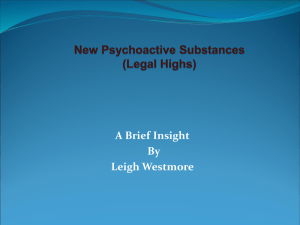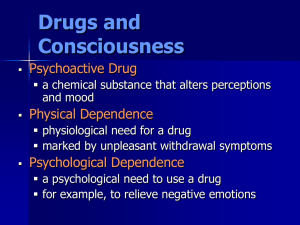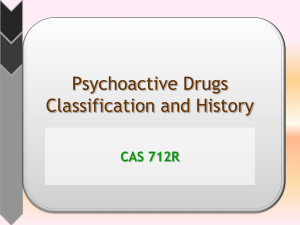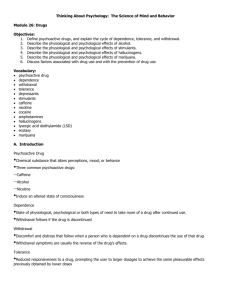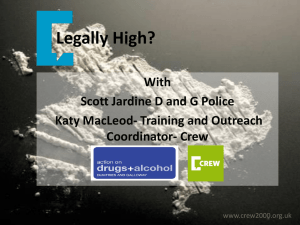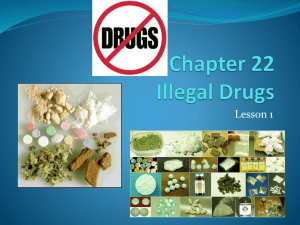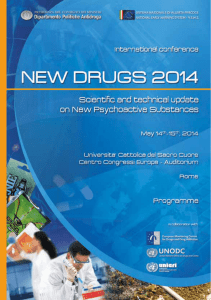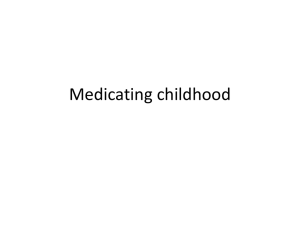Regulatory Impact Statement
advertisement
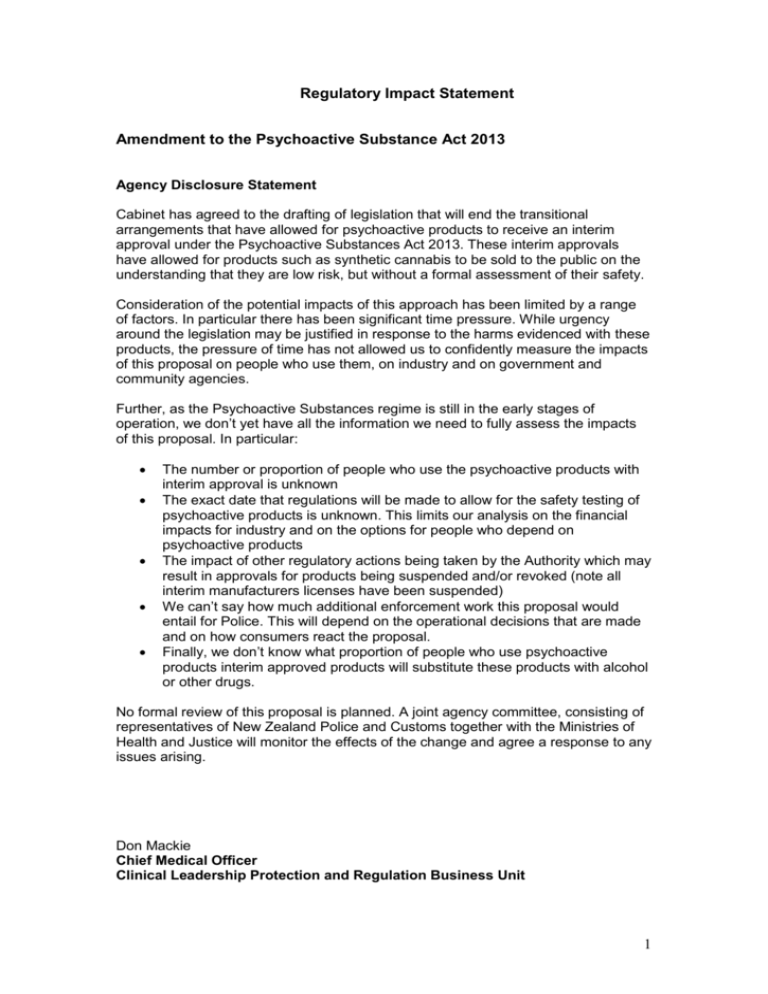
Regulatory Impact Statement Amendment to the Psychoactive Substance Act 2013 Agency Disclosure Statement Cabinet has agreed to the drafting of legislation that will end the transitional arrangements that have allowed for psychoactive products to receive an interim approval under the Psychoactive Substances Act 2013. These interim approvals have allowed for products such as synthetic cannabis to be sold to the public on the understanding that they are low risk, but without a formal assessment of their safety. Consideration of the potential impacts of this approach has been limited by a range of factors. In particular there has been significant time pressure. While urgency around the legislation may be justified in response to the harms evidenced with these products, the pressure of time has not allowed us to confidently measure the impacts of this proposal on people who use them, on industry and on government and community agencies. Further, as the Psychoactive Substances regime is still in the early stages of operation, we don’t yet have all the information we need to fully assess the impacts of this proposal. In particular: The number or proportion of people who use the psychoactive products with interim approval is unknown The exact date that regulations will be made to allow for the safety testing of psychoactive products is unknown. This limits our analysis on the financial impacts for industry and on the options for people who depend on psychoactive products The impact of other regulatory actions being taken by the Authority which may result in approvals for products being suspended and/or revoked (note all interim manufacturers licenses have been suspended) We can’t say how much additional enforcement work this proposal would entail for Police. This will depend on the operational decisions that are made and on how consumers react the proposal. Finally, we don’t know what proportion of people who use psychoactive products interim approved products will substitute these products with alcohol or other drugs. No formal review of this proposal is planned. A joint agency committee, consisting of representatives of New Zealand Police and Customs together with the Ministries of Health and Justice will monitor the effects of the change and agree a response to any issues arising. Don Mackie Chief Medical Officer Clinical Leadership Protection and Regulation Business Unit 1 The Status Quo Current regulatory environment 1. The Psychoactive Substances Act (the Act) came into effect on 18 July 2013. The Act establishes a regulatory regime to control the importation, manufacture, and sale of psychoactive substances. Prior to enactment of the legislation there were between 200-300 unregulated psychoactive substances that existed in a grey area outside the controls of other legislation such as the Misuse of Drugs Act and the Medicines Act. 2. The Act addressed the Government’s concerns about: the availability of potentially harmful psychoactive substances with little or no control over their ingredients, potency, place of sale or purchase age; and the onus on government to identify and determine if the substances are harmful before placing restrictions on them. 3. Prior to enactment, the process for controlling psychoactive substances was onerous and unsuited to the rapid growth of novel synthetic substances. The Act places pre-market controls on psychoactive substances and prohibits the importation, manufacture and sale of any psychoactive substance (that is not alcohol, food, a drug controlled under the Misuse of Drugs Act, medicine, or tobacco) unless it can be demonstrated that the substance poses no more than a low risk of harm. This effectively takes the onus away from Government to prove the harmfulness of individual substances and puts the onus on industry. This is similar to the way that new medicines, novel foods and hazardous substances must meet a safety threshold before they can be marketed. 4. The following provisions of the Act came into force in July 2013: I. establish a regulatory authority within the Ministry of Health with functions to: a) b) c) d) II. III. IV. V. consider and grant approvals for products establish a code of manufacturing practice issue licences for importation, research, manufacture, and retail carry out monitoring, recall and audit functions; establish an expert advisory committee to give technical advice to the regulator establish offences and penalties for importing, manufacturing or selling without a licence, breaching licensing conditions, possession of an unapproved substance, and breaching regulations around advertising, display, purchase age etc prohibit the sale of approved products from certain outlets, including dairies allow territorial authorities to introduce local approved product policies 5. The Act also establishes regulation-making powers to prescribe the information required in an application for approval, advertising, labelling and packaging, health warnings, and dosage requirements. 2 6. The regulations have not yet been made and are required to ensure the workability of the legislation. The most significant of these in terms of workability are the regulations that prescribe the information industry will be required to provide in applying for approval of a product. The development of these regulations will require decisions on the threshold of low risk and the evidence that will be needed, in terms of results of pre-clinical and clinical trials, to demonstrate it. What are the interim provisions? 7. In order to bridge the gap between the enactment of the legislation and the introduction of the regulations, a number of transitional provisions were included in the legislation. Without these provisions, on the day of commencement, all substances would automatically have become unapproved and their importation, manufacture, sale, and possession would have been prohibited. The transitional arrangements were introduced to minimise the risk of black market activity under the assumption that demand for psychoactive substances would continue irrespective of the existence of a legal market. 8. The Act establishes transitional arrangements for products and businesses already operating in the market at the time of enactment. Any products that had been traded for at least three months without giving rise to safety concerns (as assessed by considering reported adverse reactions) were granted interim approval on application. Similarly, retail premises that had been trading for at least 28 days were able to obtain interim licences to continue trading, unless the type of premises had become prohibited – such as dairies. 9. With the exception of the requirement to undergo a full testing regime, the other provisions of the Act came into force in July 2013, including retail controls on products with an interim approval such as purchase age and an advertising restriction. There is provision for territorial authorities to introduce local approved products policies. A code of manufacturing practice came into effect on 18 January 2014. Testing regime 10. One of the functions of the expert advisory committee established by the Act is to evaluate, with regard to the results of trials, the harms associated with psychoactive substances submitted for approval. The Act envisages that the expert committee may need to consider data from animal tests to undertake this evaluation. 11. The Act, in combination with the Animal Welfare Act 1999, provides a framework for animal testing. Under the Animal Welfare Act, an animal ethics committee must approve any animal testing programme, and will not do so unless satisfied that the benefits of the testing justify the harm caused to the animals. 12. The Act only authorises the consideration of data from animal testing where there is no suitable alternative to non-animal tests. There is an explicit obligation to undertake an annual review and report on animal testing to refine, reduce or replace any animal tests if suitable alternative are available. Nature of the market and patterns of use 3 13. In its regulatory analysis in 2012, the Ministry provided all available data on the nature and scale of the market, and the patterns of use and harms associated with the use of unregulated psychoactive substances. A number of assumptions were made based on the market for BZP, a psychoactive substance legally available until 2008. In 2012, there was very little data on the use of synthetic cannabis-like products but it was assumed that the market, in terms of turnover and prevalence of use, was similar to BZP. Data collected since the Act came into force in July 2013 has shown that Ministry had significantly underestimated the size of the market. Products with an interim approval 14. Currently there are 35 products with interim approval, the majority of which are synthetic cannabis products designed to be smoked. The Ministry estimates that prior to the legislation there were between 200-300 products available for sale from shops, including dairies. The products that are subject to an interim approval are those products that were available in the three months leading up to enactment. This means that, since enactment, no new products have been brought to market. Twelve of the products that met this criterion at the time of enactment have since been removed from the market following concerns about their safety. Prevalence of use 15. Until the results of the 2013/14 Health Survey are available later in 2014, the Ministry has no data regarding the prevalence of use of those products with an interim approval. The Ministry estimates, based on data obtained from licence holders, that around three and a half million packets of products with an interim approval have been sold since July 2013, however we do not know how many people have purchased or used these products. Harms associated with use 16. The Psychoactive Substance Regulatory Authority (PSRA) has been tracking and analysing reports of adverse events associated with the consumption of psychoactive substances since June 2013. The PSRA receives reports from the National Poisons Centre (NPC) and the Centre for Adverse Reactions Monitoring on a monthly basis. Each month the PSRA receives notification of between 40 and 60 reports of adverse events. Most of the data received are of self-reported episodes of nausea, vomiting, agitation and other minor events that are phoned in to the NPC. Many reports do not mention a specific product, but refer generally to synthetic cannabis, and about half are general enquiries. The PSRA maintains a risk assessment framework and scoring system for adverse events. In the event that concerning adverse effects are shown to be associated with a product the Authority’s regulatory powers allow it to remove that product from the market. 17. Since July 2013 the PSRA has removed a total of 12 products from the market. All of these products have had moderate to severe adverse events reported against them such as prolonged vomiting, seizures, collapse, psychotic episodes and/or severe withdrawal reactions, on at least one occasion. Once in possession of this evidence, the PSRA is able to move rapidly to remove products that are assessed as posing more than a low risk of harm from the market. 18. The Ministry has estimated that150-200 people may have developed a dependency that may require a degree of professional withdrawal management. 4 This number has been cautiously extrapolated from the number of people accessing alcohol and other drug services at Waitemata DHB, New Zealand’s largest provider of services. Nature of the industry 19. The Ministry has issued licences to nine manufacturers of finished dose forms of psychoactive products in New Zealand. The Ministry understands that all import active ingredient, generally from China, and manufacture the finished product in New Zealand. 20. The PSRA has introduced an Importation Standard and a Code of Manufacturing Practice to improve the safety and quality of the products manufactured and sold. All manufacturing companies are required to comply with the terms of the Code and the PSRA is currently evaluating the manufacturing processes of each manufacturer against the requirements of the Code and the legislation. As a result of this assessment, all interim manufacturing licences have been suspended for non-compliance. The Authority continues to investigate the level of compliance, and ability to comply through site audits, and the expected outcome of this process is that several manufacturers will have their licences cancelled due to poor quality manufacturing systems. Industry turnover 21. The Ministry understands that the profit margins for product owners, manufacturers and sellers are large. Synthetic psychoactive substances typically, are imported from China at around $1,500-$2,000 per kilogram. A kilogram of psychoactive substance is sufficient active ingredient to manufacture around 10,000 small-medium sized packets of smokable product. The most popular products sell in packets of 1.5 to 2.5 grams and costs around $20. The Ministry understands that the cost of manufacturing a product (packaging and contents) is around $1-2 per packet. Retailers 22. There are currently 149 retailers with interim licences to sell psychoactive products. Prior to enactment, the Ministry understands that there were between 3,000-4,000 retailers. This was a much larger number than the Ministry’s 2012 estimate of 1,000 retailers. Many of those retailers were dairies and outlets that are now prohibited from applying for licences under the Act. Internet sales 23. A number of the current retail licence holders take orders via the internet. Internet sales are regulated similarly to other retail sale. Sellers must be licensed, and no advertising is permitted, except factual information at the point of sale. Retail turnover 24. Since enactment, the Ministry estimates that around three and a half million packets of products have been sold with an approximate retail value of $70 million and that the annual retail sales is likely to be around $140 million. 5 Problem definition 25. Many of the problems that the Act sought to address have been resolved by the legislation. Prior to enactment in July 2013, substances were constantly evolving and being synthesised to stay ahead of the existing unresponsive and onerous legislative controls. Substances could be sold anywhere without any controls over purchase age, marketing, labelling, or manufacturing quality. 26. The regime is currently operating in a transitional phase, and the full controls envisaged by the Act are not yet in place. Most notably, none of the products currently on the market have been subject to the full approval process, including detailed safety assessment. 27. These interim provisions were expected to last no more than six months and were introduced because of concerns about black market activity arising if no products were legally available. It was not a perfect solution as the provisions retain the pre-enactment problem of requiring the Government to react to concerns and take action, rather than putting the onus on industry to demonstrate a product meets a determined safety threshold. On balance, however, the Ministry considered that if certain products had been used prior to enactment without safety concerns, it was preferable to allow this small number of products to remain on the legal market, than expose users to a potentially more dangerous black market. 28. The interim licensing provisions enable the sale of products if they were on the market in the three months leading up to enactment without having raised any safety concerns. The PSRA has the power to remove any of these products from the market if subsequent information emerges about harms associated with their use. It was thought that a combination of only allowing products that had shown no ill effects over a three-month period and the power to remove products quickly if they did result in harm would minimise the potential impacts of the transitional phase. 29. However, since July 2013, there have been continuing concerns about the harms associated with the use of products with interim approvals, largely in relation to synthetic cannabis. While the PSRA can act quickly to take products off the market following reports of adverse reactions, this requires evidence of harm associated with specific named products. For many of the reports to the NPC and the Centre for Adverse Reactions Monitoring, it has not been possible to attribute reactions to a specific product and reports are generally a generic reference to “synthetic cannabis”. This means that the powers of the Authority are curtailed preventing the Authority from removing products from the market and to date, only 12 products have been recalled in this way. 30. The work on developing the regulations that will make the Act fully workable is on-going. It is expected that the regulations will be in place by the end of 2014. In the meantime, the Ministry has considered options to address the problems with the interim approval provisions. Animal testing 31. There has been widespread concern about the possibility that animal testing will be part of the process for approving psychoactive products. This concern has manifested in street marches, petitions, and comment on social media. Much of 6 the concern about the possibility of testing has been expressed in terms of companion animals, particularly dogs. 32. In November, Cabinet agreed that animal testing for psychoactive substances should be limited to rodents and only for the testing of carcinogenicity, reproductive toxicity and unexpected systemic effects. However, the information provided to Cabinet at this time mistakenly stated that rats, mice, and rabbits were rodents and that this would provide a sufficiently robust testing regime. Rabbits are lagomorphs and not rodents, and under the current Cabinet agreement would be excluded from the testing regime. 33. This is significant because international guidelines for the assessment of reproductive toxicity and embryotoxicity advise the use of one rodent and one non-rodent species (usually a rabbit). Limiting testing to rodents is not consistent with the international guidelines that inform New Zealand regulatory practice 34. The Psychoactive Substances Expert Advisory Committee has considered this issue, and advises that animal testing using rodents and lagomorphs, would allow the Act to function largely as intended. While it would mean some products could not be assessed, due to the application using data from non-permitted animal species potentially ruling out some low-risk products, it would allow robust assessment of the risk of at least some products. 35. The Committee consider that restricting animal testing to rodents will mean that the Act cannot function as intended. The amendment will place the regulatory framework out of alignment with international guidelines designed to protect human safety, and be contrary to the intent of the legislation. 36. By limiting access to information essential to the regulator to make a comprehensive assessment of risk, the regulator will be highly unlikely to be able to determine if a product poses no more than a low risk of harm and will have no option but to reject applications. This places the regulator at risk of judicial review as it potentially denies the applicant the possibility of product approval. Objectives: 37. The primary objective of this legislation is to immediately reduce the incidences of harm that are occurring from psychoactive products with interim approval. Secondary considerations include whether the response minimises unintended consequences, is proportionate to the nature of the problem and whether it supports the continued implementation of the Psychoactive Substances Act 38. When applying these objectives weighting needs to be given to the primary objective. Namely, whether the course of action investigated immediately removes psychoactive substances with interim approval from the market. The reasoning for this is clear; the market has failed to provide products that pose only a low risk of harm and our policy has fallen short of allowing products that pose a low risk of harm to receive interim approval. Correcting this situation is our priority and the other three objectives, whilst important will not receive the same weighting. Options: 7 39. Four options have been generated to consider against our primary and secondary objectives. These are: 1. Amend the legislation to revoke the provisions that provide for interim product approvals 2. Gather further information to identify and remove from the market only the products causing serious adverse reactions 3. Amend the legislation to achieve a complete ban on psychoactive products 4. Reduce the demand for psychoactive substances through education so fewer people use them. 40. A high level analysis of these options against the primary and secondary objectives is contained in the tables below. A more detailed elaboration of the impacts of each option and their potential mitigations is outlined in the analysis that follows. Table One: Assessment of options against the primary objective Options Primary Objective 1.Amend the legislation to revoke the provisions that provide for interim product approvals Immediately reduce incidences of harm Partial 2. Gather further information to identify and remove from the market only the products causing serious adverse reactions No 3. Amend the legislation to achieve a complete ban on psychoactive products Partial 4. Reduce demand for psychoactive products that are harmful through education No 41. Options 1 and 3 are considered to partially meet the primary objective as both will result in the removal of psychoactive products from legal sale immediately following the legislative amendment. However, as people may continue to use products that have been stockpiled in short term, or continue sourcing products from the black market, neither option can fully meet the primary objective. Nevertheless, as the continued supply of these products would be limited, the situation would improve over time. 8 Options Secondary Objectives Minimises unintentional consequences Proportionate to the nature of the problem Supports the continued 1. Amend the legislation to revoke the provisions that provide for interim product approvals 4. Reduce demand for the psychoactive products that are harmful through education No 2. Gather 3. Amend the further legislation to information to achieve a identify and complete remove from ban on the market psychoactive only the products products causing serious adverse reactions Yes No No Yes No No Yes Yes No Yes No Table Two: Assessment of the options against secondary objectives 9 implementation of the Psychoactive Substances Act 42. Options 1,3 and 4 are not well aligned with the secondary objectives. In the case of options 1 and 3 users of these products will be required to meet demand through the black market and this brings about associated harm. Conversely, Option 4 is not considered to go far enough to be deemed proportionate in addressing the harms that have been reported. 43. People who use these products are expected to stockpile them for their own personal use and the black market is assumed to stockpile to supply future demand. Because these mechanisms will provide for the continued supply of these products irrespective of legal status, use and associated harms amongst dedicated users is expected to continue. However, the cessation of legal sale can reasonably be assumed to reduce the use of these products amongst casual users. 44. Option 2 stacks up most favourably against the secondary objectives. This is because removing only the harmful products from the market allows people who use these products to substitute their use with less harmful alternatives. This mitigates any immediate concerns around withdrawal from these products and the increase in harms associated with obtaining these products from the black market. Option 2 is also the most proportionate option in terms of impacts on users and industry as it does not remove from the market those products that are have not caused adverse reactions. 45. Option 1, 2 and 4 meet the objective of supporting the continued implementation of the Psychoactive Substances Act. They allow for regulations to be made to realise the intent of the Act by only allowing onto the market products that pose a low risk. Option 3 does not meet this objective because novel psychoactive substances will continue to be traded on the black market and government will lose the ability to control harms and influence sale. Impacts and mitigation for Option 1 46. The effect of this option will be that from the date of enactment, 35 psychoactive products that have been legally traded for up to five years will become illegal. It would immediately reduce the availability of psychoactive products but due to the potential for stockpiling by people who use these products, we cannot assume it would immediately reduce harms. This option also includes provision to remove the possibility of Crown liability for compensation and will require products to be recalled and destroyed. Impact on industry 47. This option would negatively impact industry. It would immediately take all products with interim approval off the market. There will be no chance of them returning, unless they pass safety testing required by forthcoming regulations and are the subject of a full application. It is unknown when industry would be given the opportunity to do this. There will be a significant financial impact on industry participants as a result. 48. Up to 161 retailers (including suspended retailers) and 9 manufacturers of psychoactive products will be affected and it is reasonable to assume that 10 businesses will close if this option is progressed. The maximum impact is estimated at up to $60 million dollars in foregone revenue. This estimate is based on the intention that regulations to allow for product testing will be in place within 6 months. Following passage of regulations, the majority of products were expected to come off the market anyway, at least temporarily, while testing was undertaken. The figure also includes an allowance for a spike in sales before the amendment is passed. 49. The most likely response by industry would be to off load excess supply through heavy discounting prior to the legislation coming into force. Some industry members may choose to wholesale their remaining supply to black market vendors such as gangs who we expect to take over trade in these products if this option is chosen. Mitigation 50. No compensation for industry is proposed. Impact on people who use psychoactive products 51. We don’t have good data on the number of people who use psychoactive products with interim approval. 52. All people who use these products will suffer a loss of utility following their removal from the market. There will also be legal implications for them if they continue to use them. People caught in possession of these products will be liable to a fine (no conviction) of up to $500. However, if people decide to stockpile large quantities and on-sell, they will be subject to criminal penalties of up to 2 years imprisonment. 53. These legal impacts may be further complicated if we factor in issues of dependence. Some people will have developed dependence to these products, the maintenance of which will involve them in criminal activity. To estimate how many people this could apply to we have measured the utilisation of treatment services for approved products at the county’s largest alcohol and other drug service provider. This is Waitemata DHB which has a catchment for metro Auckland. Taking these usage rates and extrapolating them to the wider New Zealand population we cautiously estimate that around 150-200 people might be sufficiently dependent on these products to require a degree of professional withdrawal management. 54. Long term or heavy users of these products are likely to suffer additional impacts to their health. These impacts may affect them for a period of two weeks or longer and could manifest in symptoms such as: i. ii. iii. iv. v. vi. vii. viii. ix. cough chest pain racing heart rate shaking and twitching vomiting fainting or loss of speech and eyesight extreme anxiety and panic paranoia loss of contact with reality (psychosis) 11 x. seizures Mitigation 55. Specialist treatment services have experienced increased demand from people using psychoactive substances. There may be some increase in presentations to specialist addiction treatment services with people needing to withdraw from these products use, or experiencing withdrawal symptoms. Experience from when the new legislation was introduced was that the additional demand could be handled within current resourcing. 56. Often people may require pharmacotherapy to assist withdrawal symptoms. These medications (anxiolytics, antidepressants, anti-psychotics and antiemetics) are readily available so there are unlikely to be supply issues, but they will need to be prescribed by a medically qualified doctor. This could cause issues for services if a doctor is not always available on site. Doctors would be required if a medical managed withdrawal is required. 57. Given the estimated number of people that might need this service (150-200) we do not anticipate staffing capacity issues. We are, however, concerned about the ability of these people to pay for doctors services for medically managed withdrawal and have not considered mitigation for this problem in the time available. A further risk is that a patient undergoing medically managed withdrawal could develop a reliance on the tranquillisers used in this treatment. However, this would only be a significant issue if the person was prescribed these over an extended period of time. Impact on government and community agencies 58. New Zealand Police, New Zealand Customs Service and District Health Boards will be impacted by this proposal. 59. Following the removal of the interim approvals New Zealand Police will take enforcement action and may lay charges against people caught in possession of psychoactive products. The extent of this will depend on both the number of people who continue to possess psychoactive products and the operational policy applied by Police in these circumstances. 60. The New Zealand Customs service can expect to see a reduction in the licensed importation of the substances used in the manufacture of psychoactive products. Based on there being 9 licensed importers of these substances, the impact of this option is expected to be low. 61. Work and Income New Zealand and the Ministry of Education may require advice on how to approach and best assist their clients or students that are showing signs of withdrawal from these products. 62. District Health Boards could expect to see an increase in demand for addiction treatment services. Primary care services may be called on to assess and treat people with withdrawal symptoms. The government funded AlcoholDrug helpline can expect to receive an increase in calls. Mitigation 12 63. The impact on primary care services could be mitigated by the Ministry publishing information for primary care on how to handle people with withdrawal symptoms, and proposing referral to specialist services. 64. The AlcoholDrug helpline currently has capacity to meet increased demand within current service configurations. If these configurations changes and the helpline needed to operate for longer hours, additional assistance would likely be required. Impacts and mitigation for Option 2 65. This option would utilise the provisions of recall in the Act to remove only the products that are clearly causing adverse reactions in users. It would take time to ascertain those products that would be affected and would not address the problem of immediate harm. Impact on industry 66. This option would have less impact on industry than option one identified above. Only the products that are harmful would be removed from sale. Mitigation 67. No mitigation would be necessary as only the products that are harmful would be removed from sale. This is a proportionate and justified response. Impact on government and community agencies 68. Agencies may require additional resourcing to promote and communicate to the health sector and users the importance of adverse reactions monitoring. Two hundred thousand dollars is available from proceeds of crime funding to support promotional activity. Mitigation 69. Mitigation is not required. Impact on people who use psychoactive products 70. Impacts on people who use psychoactive products would be minimal. Access to harmful products would be removed but low risk products would remain available. However, those who had developed a dependency to products that were removed from the market might either resort to the black market to satisfy demand or may require support to address their dependency. Mitigation 71. Mitigation is not required. Impacts and mitigation for Option 3 72. This option would involve using the definitions under the existing legislation to achieve a full prohibition on the legal sale of all psychoactive products. The way the existing legislation works is that it is prohibited to import, manufacture, sell or possess any psychoactive substance unless it has been approved. By removing 13 the ability to obtain an approval, a complete ban of all psychoactive substances not exempted from the legislation (ie; alcohol, tobacco, medicines and food) would be achieved. 73. Owing to the fact that the definition of psychoactive substance is very broad, this option would inevitably capture and place legal penalties around substances that potentially pose no harm. [Information withheld under section 9(2)(h) of the Official Information Act 1982 to maintain legal professional privilege]. An outright ban would criminalise behaviour that is not necessarily harmful and breach the constitutional principle of proportionality. Impact on industry 74. The impacts for this option are the same as that for Option 1. For example, forgone revenue and the possible closure of business. However, under this option, industry would permanently lose the ability to bring psychoactive products to the market irrespective of how safe future products may be. Mitigation 75. Mitigation is not possible. Impact on government and community agencies 76. Police and Customs would be required to enforce a prohibition on a potentially endless number of novel psychoactive substances. The black market would increase in size as would the number of people involved in criminal activity. Mitigation 77. Mitigation is not possible. Impact on people who use psychoactive products 78. The impacts on people who use these products would be the same as for Option 1, for example, the potential for users to suffer withdrawal and the crimimalisation of people in possession of psychoactive products . Mitigation 79. Mitigation would be limited to initiatives that reduce the demand for psychoactive products. Impacts and mitigation for Option 4 80. This option involves seeking to reduce demand for psychoactive products through education in place of influencing supply. This option is not expected to immediately reduce harm. Impact on industry 81. Impacts on industry are minimal. Mitigation 14 82. Mitigation would not be required Impact on government and community agencies 83. Community agencies may be engaged to tailor demand reduction programmes specific to the needs of their locality. This can likely be delivered by regional Community Action on Youth and Drugs providers. Mitigation 84. Not required Impact on people who use psychoactive products 85. The continued legal availability of harmful psychoactive products could affect consumers. However, equipping them with knowledge of what the harmful products are would go some way towards offsetting this. Mitigation 86. Demand reduction programmes would need to prioritise the provision of advice on the most harmful products. Consultation 87. Due to time constraints, consultation on this issue has been limited to four government departments. These are New Zealand Police, the New Zealand Customs Service, the Ministry for Primary Industries and the Ministry of Justice. 88. The Ministry of Health has not involved industry or the consumers of psychoactive products in considering the options and objectives contained in this this Regulatory Impact Statement. However, the Psychoactive Substances Regulatory Authority has engaged with industry on compliance issues. Conclusion and recommendations 89. Of the four options identified, only the two legislative options go some way to meeting the purpose objective of immediately reducing harm. These are: Option 1 - amending the primary legislation to revoke product approvals, and Option 2 - amending the legislation to provide for a total ban, 90. Both options will have significant impacts on people who use psychoactive products and industry. These impacts include: a loss of utility from the use of psychoactive products, criminal implications on people who use these products, the involuntary withdrawal from these products by some people who are dependent of them the substitution of these products with alcohol or other drugs which in some cases, may be more harmful forgone revenue by industry not expected to exceed $60 million closure of businesses and loss of jobs. 15 91. Reducing harm to individuals has greater value than the costs that will be incurred by industry. Care will be needed to ensure the estimated 150-200 people heavily dependent on these products, who may need support in managing their withdrawal. This is a serious impact with possible medical complications. However, the Ministry considers that the benefits of reducing harm to the wider population must take precedence over the needs of this select group. 92. Of the remaining two options, the Ministry’s recommends option 1. [Information withheld under section 9(2)(h) of the Official Information Act 1982 to maintain legal professional privilege]. An outright ban would criminalise behaviour that is not necessarily harmful, breaching the constitutional principle of proportionality. Legislation Advisory Committee guidelines highlight the importance of criminal behaviour being defined with precision. Yet past experience with definitional difficulties suggests that a total ban is unlikely to be legally or practically workable. Implementation Plan 93. The Ministry of Health and Police are working closely together to plan for the enforcement of the changed provisions. Police and enforcement officers from the Psychoactive Substances Regulatory Authority will make joint visits to retailers following the change to ensure no sales are taking place or products being stored. Joint visits to prepare for the change have already taken place in some areas. 94. Addiction issues are an important consideration. An estimated 150 to 200 people may be dependent on products they can no longer obtain, and could suffer withdrawal symptoms. The Ministry of Health is confident that any increase in demand for treatment services can be met through current arrangements. 95. The Ministry of Health is taking steps to ensure that the people who are dependent on these products know where to find help, anyone in need of help is advised to contact the AlcoholDrug helpline on 0800 787 797 or their local DHB alcohol and drug service in the first instance. The Ministry is also updating key messages on our website to provide information specific to withdrawal from psychoactive products. This content will also include a template that local alcohol and drug service providers can populate with their details and promote through local networks such as regional consumer groups in order to connect with clients. 96. Information for treatment services and wider health services are also available from: http://www.matuaraki.org.nz/library/matuaraki/substance-withdrawalmanagement-guidelines-for-medical-and-nursing-practitionershttp://www.matuaraki.org.nz/library/matuaraki/substance-withdrawalmanagement-guidelines-for-addiction-and-allied-practitioners Monitoring, evaluation and review 97. The impact of the law change will be monitored through existing reporting mechanisms, such as regular drug surveys and police and hospital reports. A joint agency committee, consisting of representatives of New Zealand Police and Customs together with the Ministries of Health and Justice will monitor the effects of the change and agree a response to any issues arising. 16 98. No formal review is planned. Regulations giving effect to the full regulatory regime envisaged by the Act are in development, and will supersede the effect of the recommended option before the end of 2014. 17
